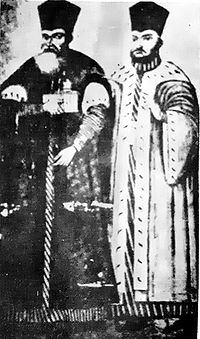
Antioh Cantemir
Encyclopedia

Constantin Cantemir
Constantin Cantemir was a Moldavian Voivode between June 25, 1685 and March 27, 1693.-Life:Cantemir became a voivode at the age of 71, after being favored by the Ottoman Empire in his conflict with Dumitraşcu Cantacuzino...
and older brother of Dimitrie Cantemir
Dimitrie Cantemir
Dimitrie Cantemir was twice Prince of Moldavia . He was also a prolific man of letters – philosopher, historian, composer, musicologist, linguist, ethnographer, and geographer....
(not to be confused with Antiokh Dmitrievich Kantemir, Dimitrie's son), was a Moldavia
Moldavia
Moldavia is a geographic and historical region and former principality in Eastern Europe, corresponding to the territory between the Eastern Carpathians and the Dniester river...
n Voivode (Prince) between December 18, 1695 and September 12, 1700, and again from February 23, 1705 to July 31, 1707.
Reigns
He and Dimitrie successfully plotted against Prince Constantin Duca (who had obtained the throne, after having Dimitrie deposed by the OttomansOttoman Empire
The Ottoman EmpireIt was usually referred to as the "Ottoman Empire", the "Turkish Empire", the "Ottoman Caliphate" or more commonly "Turkey" by its contemporaries...
, with the backing of Constantin Brâncoveanu
Constantin Brâncoveanu
Constantin Brâncoveanu was Prince of Wallachia between 1688 and 1714.-Ascension:A descendant of the Craioveşti boyar family and related to Matei Basarab, Brâncoveanu was born at the estate of Brâncoveni and raised in the house of his uncle, stolnic Constantin Cantacuzino...
, Prince of Wallachia
Wallachia
Wallachia or Walachia is a historical and geographical region of Romania. It is situated north of the Danube and south of the Southern Carpathians...
).
Unlike his father, Antioh was not adverse to Poland
Polish-Lithuanian Commonwealth
The Polish–Lithuanian Commonwealth was a dualistic state of Poland and Lithuania ruled by a common monarch. It was the largest and one of the most populous countries of 16th- and 17th‑century Europe with some and a multi-ethnic population of 11 million at its peak in the early 17th century...
; he also planned for an anti-Ottoman alliance with Russia (then under Peter the Great
Peter I of Russia
Peter the Great, Peter I or Pyotr Alexeyevich Romanov Dates indicated by the letters "O.S." are Old Style. All other dates in this article are New Style. ruled the Tsardom of Russia and later the Russian Empire from until his death, jointly ruling before 1696 with his half-brother, Ivan V...
), one that was came to be during Dimitrie's rule - the full impact of Russia's growth had been felt after the 1699 Treaty of Karlowitz
Treaty of Karlowitz
The Treaty of Karlowitz was signed on 26 January 1699 in Sremski Karlovci , concluding the Austro-Ottoman War of 1683–1697 in which the Ottoman side had been defeated at the Battle of Zenta...
.
Although Cantemir increased taxes (especially during his second reign), he was a popular figure, generally viewed as a just and kind ruler. In 1707, he established the Princely Academy in his capital Iaşi
Iasi
Iași is the second most populous city and a municipality in Romania. Located in the historical Moldavia region, Iași has traditionally been one of the leading centres of Romanian social, cultural, academic and artistic life...
, inspired by Chrysanthus, the Orthodox Patriarch of Jerusalem
Orthodox Patriarch of Jerusalem
The Greek Orthodox Patriarch of Jerusalem is the head bishop of the Orthodox Church of Jerusalem, ranking fourth of nine Patriarchs in the Eastern Orthodox Church. Since 2005, the Orthodox Patriarch of Jerusalem has been Theophilos III...
, but largely secular
Secularism
Secularism is the principle of separation between government institutions and the persons mandated to represent the State from religious institutions and religious dignitaries...
.

